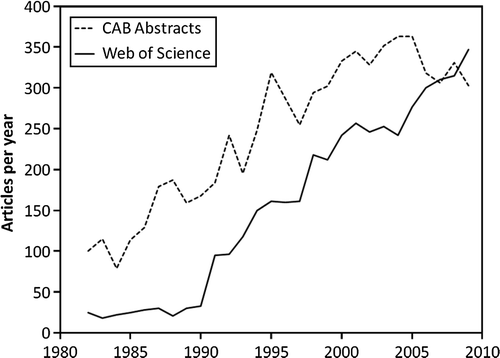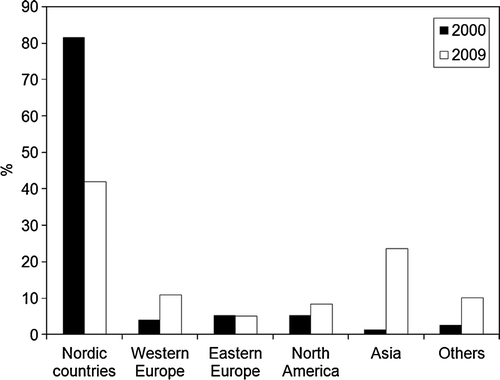The Scandinavian Journal of Forest Research has served the needs of the forest science community since 1986. So 2010 sees the publication of the 25th consecutive volume. The journal has evolved from one with an applied, regional profile, to an international journal with global contributions. The changes to the journal also reflect the development of the field of forest science. This short article gives some insight into the story of the Scandinavian Journal of Forest Research.
The 1980s – Nordic researchers start to publish internationally
In the early 1980s, scientific results from Nordic forest researchers were mostly released in series of internal or domestic reports. Peer-review was not a common procedure, and much of the reported research had an applied profile.
During the decade, however, there was a rapid transition to publishing in international journals in order to be considered successful; this was probably at the expense of traditional reporting in native language series. shows the increase in journal publications from Swedish authors writing about forestry. The dashed line shows journal articles listed in CAB Abstracts, which includes more journals than those listed by the Web of Science®. The shape of the two curves may indicate that, over time, authors prioritized journals with a higher impact, since only selected publications are included in the Web of Science® journal databases.
Figure 1. Number of articles published in the category “Forest” from CAB Abstracts and the Web of Science® (in the period 1982–2009) with at least one author from Sweden.

The awareness of international publication rose in the 1980s, but Scandinavian authors found it difficult to gain access to the journals that were most widely recognized, internationally, at that time. The establishment of the Scandinavian Journal of Forest Research was a means to solve this problem.
1986 – The birth of the Scandinavian Journal of Forest Research
The initiative to establish a new journal came from the Royal Swedish Academy of Agriculture and Forestry (KSLA), but discussions soon started with the Nordic Forest Research Cooperation Committee (SNS) about the need to establish a journal covering the Nordic arena.
The first ever issue of the journal was published in 1986. The publisher was Almqvist & Wiksell Periodical Company, with SNS and KSLA as the organizations supporting the publication. From the beginning, the journal was established with a high scientific profile, stating that “contributions should be original papers of high scientific quality and international interest”. The aim and scope paragraph also included instructions that research should be of “relevance to Nordic conditions” and “have a certain preference to subjects having a more direct practical application.”
The applied nature of the profile was well illustrated in the first issues of the journal. The first ever article was Lindström et al. (Citation1986), presenting information on a collar to protect against damage by pine weevil. Other articles touched on applications such as storage of seedlings, rooting spruce cuttings, and the consequences of subsidies in forestry.
Basic research has also played an important role in the publication. Even in the first issue, several articles dealt with basic genetic and physiological issues. The journal has since achieved a balance between applied and basic research, but has still maintained a focus on papers describing results that may have practical relevance.
From a Nordic to an international perspective
The primary aim of the journal, to give priority to research of “relevance to Nordic conditions” was soon abandoned, and today articles are accepted from all over the world, as long as they are relevant to forests and forestry in boreal and temperate regions. The share of manuscripts from Nordic authors has steadily decreased over time, from over 80% ten years ago, to about 40% in 2009 (). Previously, international contributions often originated from North America and Europe. Today, new regions are emerging, with increasing numbers of manuscripts from China, Turkey, Iran, and eastern and southern Europe.
Figure 2. Proportion of manuscripts submitted to the Scandinavian Journal of Forest Research from different regions in 2000 (N=76) and 2009 (N=119).

The story of the Scandinavian Journal of Forest Research reflects the move from an applied, regional journal to an internationally reputable one. In the 1980s, the journal was technically administered by KSLA and had a board of national editors. In 1990, KSLA sold the journal to Scandinavian University Press, but SNS remained responsible for its scientific focus. An agreement with SNS states that the organization is responsible for appointing the editor and editorial board, and also for safeguarding the scientific quality of the journal. In 1991, the first scientific editor-in-chief was appointed. Dr Anders Ericsson, currently Professor at Umeå Plant Science Center, took on this responsibility for the subsequent nine years. During this period, the journal became more internationally oriented, both in terms of contributions and in terms of referees. The aim was to find at least one reviewer for each article from outside the Nordic countries. This strategy probably helped to raise the international profile of the journal.
The ownership of the journal was handed over to Taylor & Francis in 2000, and has remained there ever since. Dr Hans-Örjan Nohrstedt took over as scientific editor the same year, and he was succeeded by the current editor, Dr Mats Hannerz, in 2001.
Over 1300 research articles
The 1999 volume saw the number of issues increase from four to six, allowing more articles to be printed. At the same time, SNS started to publish its newsletter News and Views. The aim was to present information on research items of relevance to the forest industry sector.
A total of 1312 peer-reviewed research articles were published during the period 1986-2009, giving an average of 55 per year. The average numbers rose in 1999 with the increase in the number of issues. The publication of occasional special issues (Supplements) have raised the numbers of articles in some years.
Nowhere near all submitted manuscripts are accepted for publication. The rejection rate has been around 40-50% in the last few years. With more submitted manuscripts, more are likely to be rejected. There seems, however, to be a high degree of “self-rejection” for those submitting manuscripts to the journal. The number of papers which are immediately returned due to poor quality is, therefore, limited. The main reason for a direct rejection is usually that the paper is not within the scope of the journal.
Impact factor
The impact factor of a journal is a measure of the number of citations to articles in the two years following publication. This 2-year impact factor has become a proxy for the scientific impact of a journal, and all journals strive to increase it. However, as described by Hannerz (Citation2010a), for example, the 2-year impact factor is not always the most relevant measure for forestry journals. Articles in the forest research sector often have a long life-span (with a citation half-life of eight years for this journal). Many journals now publish their 5-year impact factor as a complement to the traditional 2-year figure.
The Scandinavian Journal of Forest Research is listed in the subject category “Forestry” in the Journal Citation Reports, issued annually by Thomson Reuter. It is ranked (for the 2009 data) as number 21 among the 46 journals when measured on the basis of the 2-year impact factor. Using the 5-year impact factor, the ranking rises to 15.
Table 1. Impact factors and Eigenfactor metrics for 2009 for the Scandinavian Journal of Forest Research. “Ranking” indicates the rank among the 46 journals listed in the subject category “Forestry” in Thomson Reuter's Journal Citation Reports® 2010.
In order to increase the impact factor, the editors need to select papers that will be cited frequently’. An unpublished analysis of 169 articles that appeared in the journal between 1997 and 1999 revealed that the 15% most cited articles received 50% of all citations (within the 2-year impact factor window). The 50% most cited articles collected over 90% of the citations. In other words, the most cited half of the articles received 10 times more citations than the least cited half (Hannerz, 2002, unpublished). These results confirm a previously established “15/50 and 50/90 rule” (Seglen, Citation1997).
However, articles that are not immediately cited may still be important contributions to science. One example (see Hannerz, Citation2010a) is a review article published in 1999 which received no citations in the following two years. By 2009, however, it had received 71 citations. The analysis of the 169 articles mentioned above also showed that most articles (over 80%) will eventually be cited. In addition to these citations, one must also consider all citations in the literature, not just those listed in the Web of Science.
The future
Researchers will always need to find forums through which they can communicate their ideas. Although new communication channels will arise, such as self-posting articles on the web, there will continue to be a demand for a reviewing process that guarantees scientific quality. The Scandinavian Journal of Forest Research is currently an important player in the forest research arena. However, it should not be taken for granted that this position will be maintained forever. The journal is competing in a market where new journals are born every day, with new ideas about the dissemination strategy and production economy. The demand for open-access publication is also a challenge to traditional journals with copyright. Research councils in many countries require that research funded by them is published in open-access journals, or archived in open databases (see Hannerz, Citation2010b).
Being the editor, I see two trends in forest research that have implications for the journal. The first is that forest scientists have become more specialized than they were 25 years ago. Whatever their specialism, whether entomology, soil science or ecological modeling, they want to interact with other specialists in their own arena, and also to publish in journals devoted to their own field.
The other trend is that much research has become multi-disciplinary. Studies that mix economics and ecology, or social behavior and physical management, require arenas that are wide and provide access to research from other fields. A broad forest journal will satisfy these needs.
Will there be a jubilee issue of the journal in 2035, on its 50th birthday? I am convinced that the journal will continue to serve researchers in some form in the future. A prerequisite is that it adapts to ever-changing conditions. The thrilling fact is that we do not know what these conditions will be.
Acknowledgements
Staffan Parnell, SLU University Library in Uppsala, provided the data from CAB and the Web of Science used in .
References
- Hannerz , M. 2010a . From the editor. Top-cited articles 2001–2009 . Scandinavian Journal of Forest Research , 25 : 1 – 2 .
- Hannerz , M. 2010b . New rules from 2010. Swedish funding requires open access. News & Views . Scandinavian Journal of Forest Research , 25 : 198
- Lindström , A. , Hellqvist , C. , Gyldberg , B. , Långström , B. and Mattsson , A. 1986 . Field Performance of a Protective Collar against Damage by Hylobius abietis . Scandinavian Journal of Forest Research , 1 : 3 – 15 .
- Seglen P.O 1997 Why the impact factor of journals should not be used for evaluating research British Medical Journal February 1997 314 497